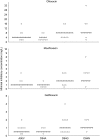Association of gyrA/B mutations and resistance levels to fluoroquinolones in clinical isolates of Mycobacterium tuberculosis
- PMID: 26038513
- PMCID: PMC3974338
- DOI: 10.1038/emi.2014.21
Association of gyrA/B mutations and resistance levels to fluoroquinolones in clinical isolates of Mycobacterium tuberculosis
Abstract
To evaluate the association between mutations in the genes gyrA/B and resistance levels to fluoroquinolones in clinical isolates of Mycobacterium tuberculosis, a total of 80 ofloxacin-resistant isolates collected in 2009 by the Shanghai Municipal Centers for Disease Control and Prevention were studied. The minimum inhibitory concentration (MIC) of ofloxacin, moxifloxacin and gatifloxacin for each isolate was determined using the microscopic observation drug susceptibility assay. Sequencing was used to identify mutations in the quinolone resistance-determining region (QRDR) of the gyrA and gyrB genes. In total, 68 isolates had mutations in gyrA, three isolates had mutations in gyrB, six isolates had mutations in both gyrA and gyrB, and three isolates had no mutations. Two common mutations in gyrA, the D94G and D94N mutations, were associated with higher-level resistance to all three fluoroquinolones than two other common mutations (A90V and D94A). Understanding the relationship between MICs and mutations in ofloxacin-resistant isolates will facilitate the optimization of the use of new-generation fluoroquinolones to treat patients with ofloxacin-resistant tuberculosis (TB).
Keywords: M. tuberculosis; MICs; fluoroquinolones; mutations.
Figures

References
-
- Falzon D, Jaramillo E, Schünemann HJ, et al. WHO guidelines for the programmatic management of drug-resistant tuberculosis: 2011 update. Eur Respir J. 2011;38:516–528. - PubMed
-
- World Health Organization Multidrug and extensively drug-resistant TB (M/XDR-TB): 2010 global report on surveillance and response Geneva: WHO; 2010. Available at http://www.who.int/tb/features_archive/m_xdrtb_facts/en/ (accessed 20 December 2013).
-
- Xu C, Kreiswirth BN, Sreevatsan S, et al. Fluoroquinolone resistance associated with specific gyrase mutations in clinical isolates of multidrug-resistant Mycobacterium tuberculosis. J Infect Dis. 1996;174:1127–1130. - PubMed
LinkOut - more resources
Full Text Sources
Other Literature Sources
Molecular Biology Databases
